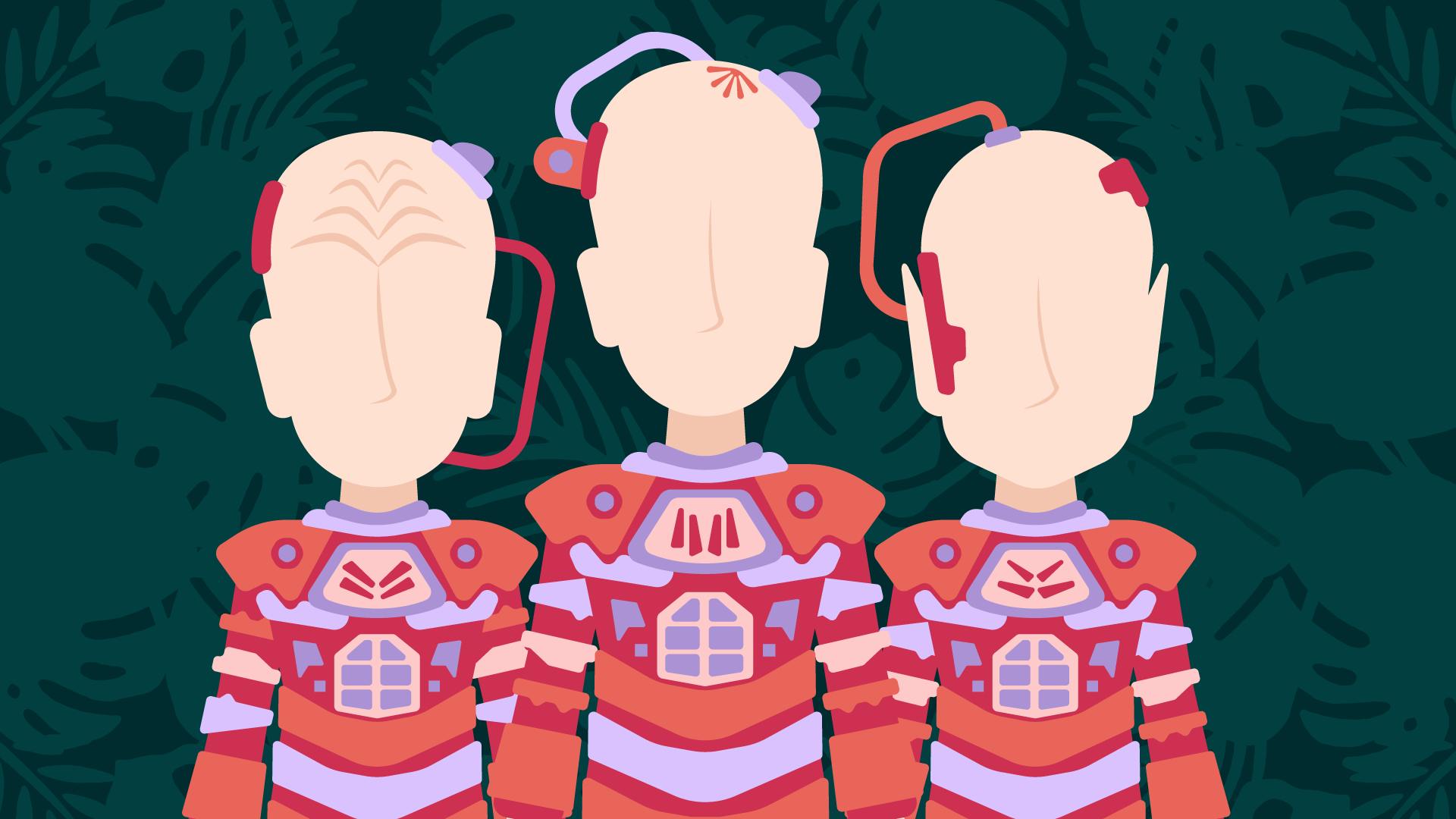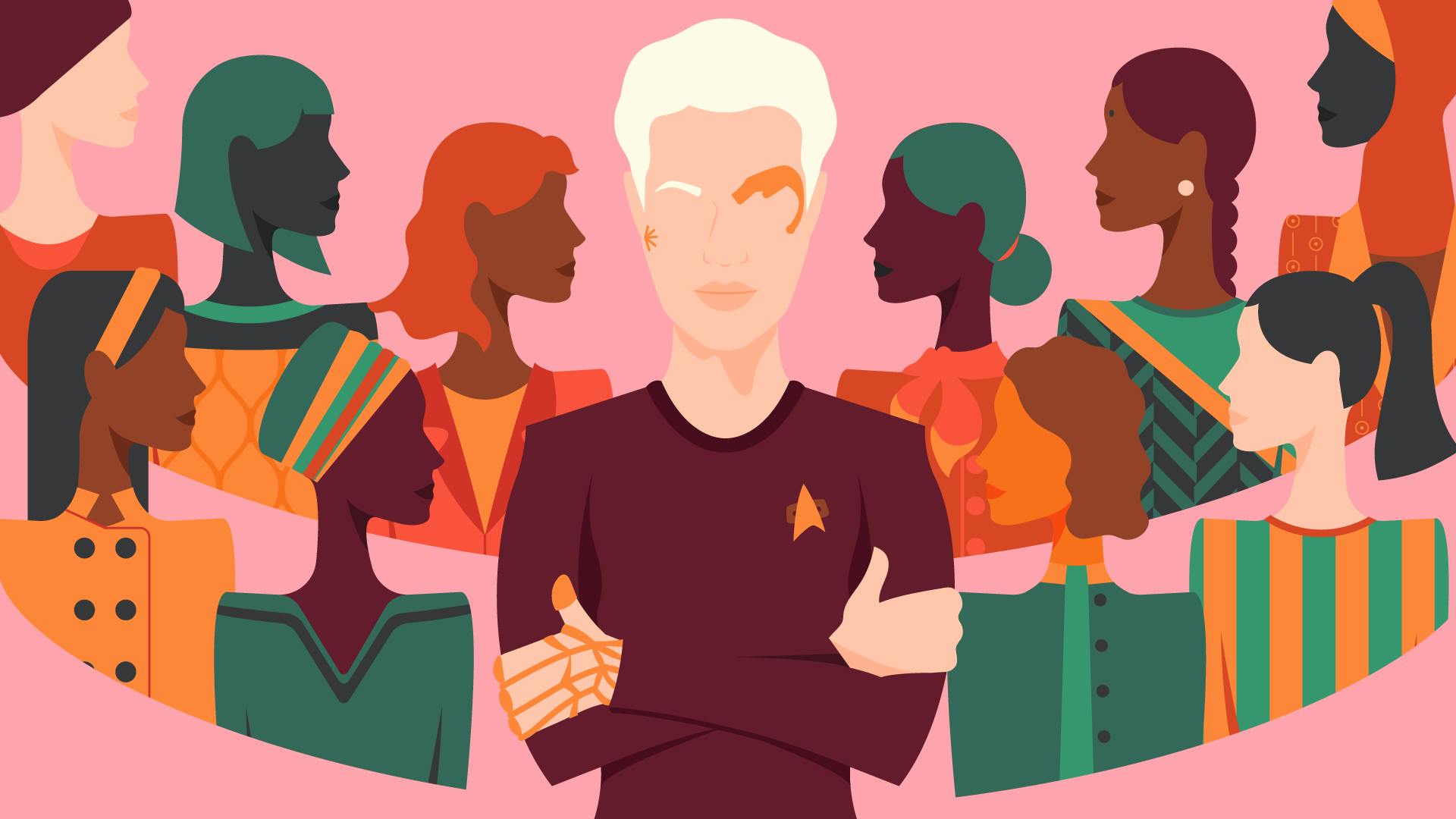Published Jun 28, 2023
In 'Lifesigns,' It's What's on the Inside That Counts
Star Trek: Voyager tackles love and self esteem in this hologram centric episode.
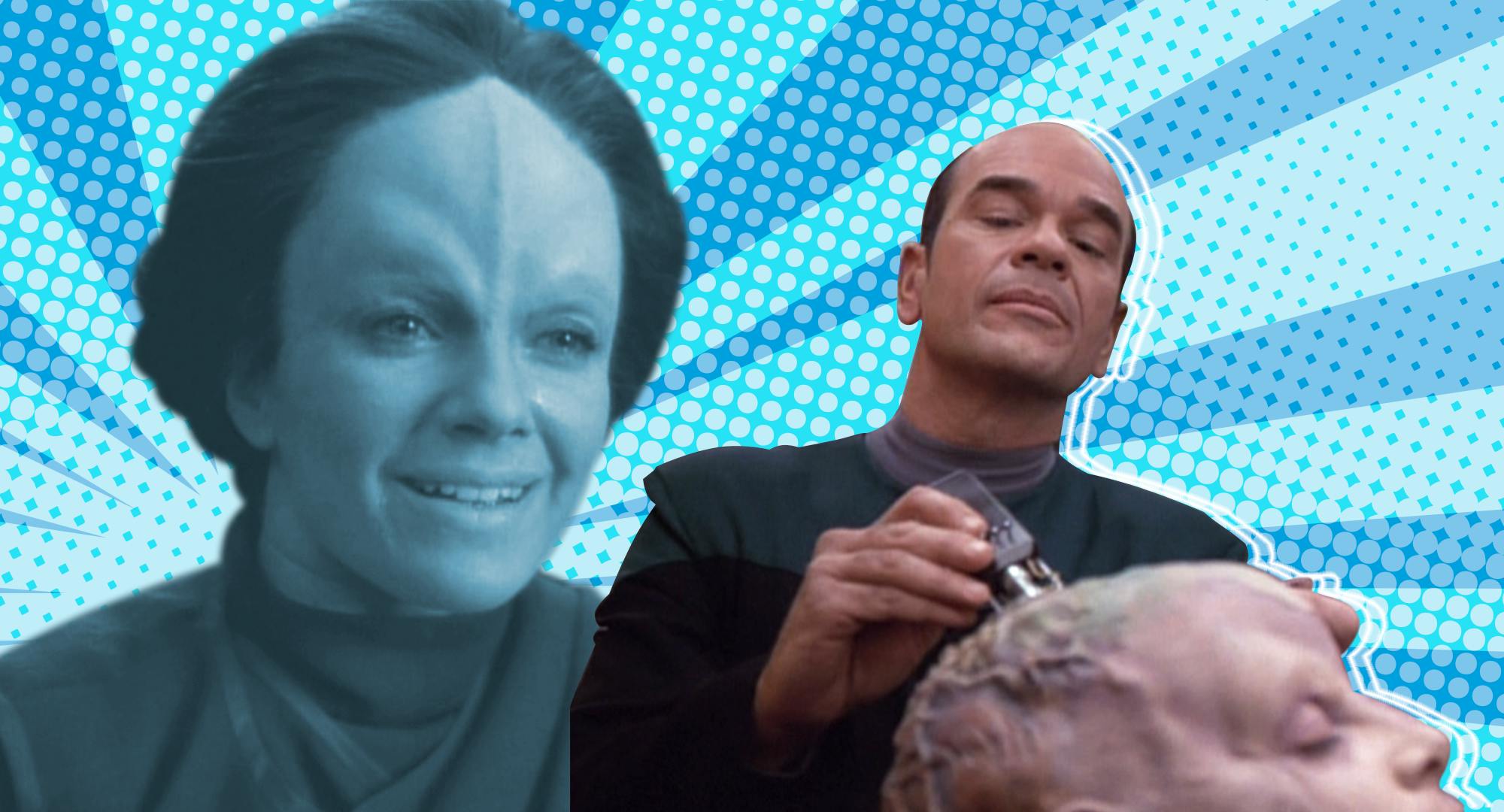
StarTrek.com
There are many romances in Star Trek: Voyager; some canon, some not.
But there’s always been one tale of finding love that has stayed with me — that of The Doctor and Danara Pel as seen in the second season episode, “Lifesigns.” He’s a hologram; she’s a Vidiian doctor sickened with the Phage and on the brink of death. But they find a kindred spirit in one another, and a love like that is particularly important in this day and age.
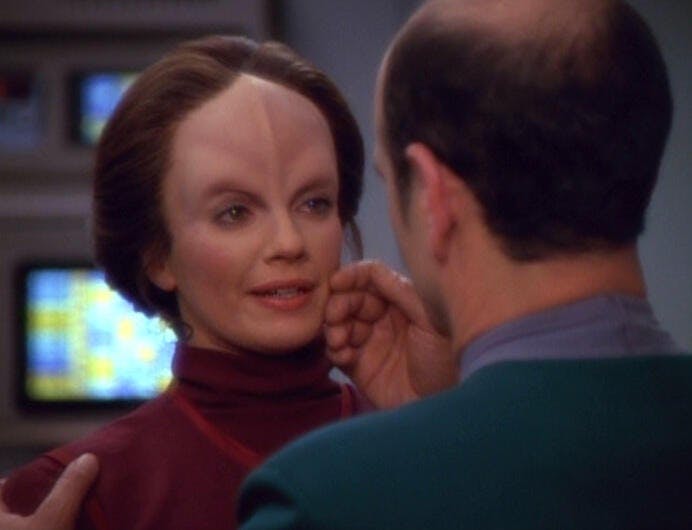
StarTrek.com
The world, media, and especially the internet is so focused on looks and perfection that it’s hard not to feel inferior to everyone. As someone who has fallen victim to using beauty tools to get that perfect selfie, almost to an obsessive degree, the heart of the relationship between Danara and The Doctor serves as a stark reminder that it's not the face that matters; it's the heart.
Romance is Not a Malfunction
Initially, The Doctor uses the holographic program to re-create Danara Pel’s body in order to better understand Vidiian biology in an effort to heal her. Unknowingly, he has also restored her to what she was before the Phage, or rather, how she would look now if the disease hadn’t taken a hold of her as a child.
Danara’s reaction at seeing herself in the mirror — beautiful and unscarred by the disease that has ravaged her people — is both heartwarming and distressing. Her new body is fake. It’s not her, but a projection of her original DNA code. Her joy at seeing herself as she should be, as she wants to be, can’t help but tug at the heartstrings.
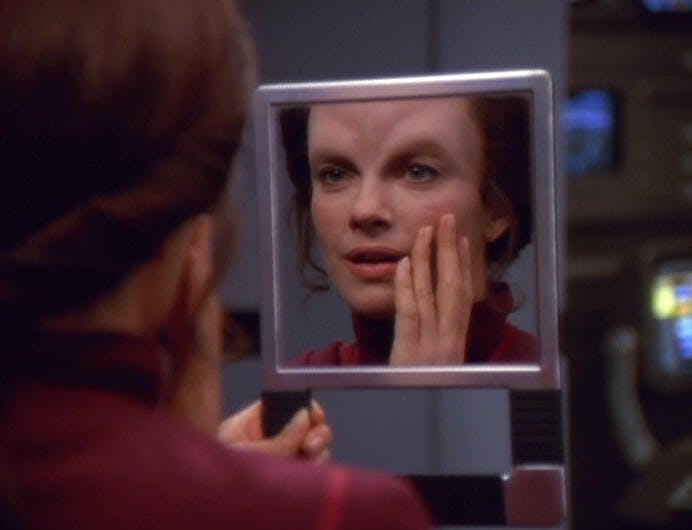
StarTrek.com
“I never thought I’d see myself again,” she says. Her reaction to seeing her actual body in stasis is another jab at viewers’ emotions. It’s all an illusion, but one that brings her profound joy and a sense of peace that she hasn’t felt for most of her life. For the first time in ages, Danara gets attention. She’s called "beautiful," is asked to dance, and is shocked that people treat her normally.
Seeing an image reflecting the version of yourself you wish was reality is something a lot of people struggle with today. With apps, filters, lenses, and Photoshop, we can create these picture perfect versions of ourselves to post online. So much of what’s on social media has been edited or carefully posed and planned. The fake version of our lives we present to the internet-at-large is a double-edged sword. We’re deluding ourselves that this is actually the life we have. At the same time, we’re fooling other people who look at these carefully crafted photos and videos and envy the fact that they don’t have what is there, or live up to an Instagram influencer’s version of perfection.

StarTrek.com
But it’s all just a ruse, isn’t it? For everyone. A lot of this is because of the accessibility of such software. There’s thousands of these sorts of apps, like FaceTune, BeautyPlus, and Snow. Each one allows you to tweak your features in any way you see fit — larger eyes, a narrow face, a smaller nose, you name it. Some are, yes, more realistic than others, but when you’re looking to create a social media friendly version of yourself that can garner likes and compliments, does reality really matter?
I do not have an illness that affects my physical appearance. Instead, I suffer from mental illness, which allows chronic thoughts that decimate my self-esteem to run amuck. I see myself as too fat, too broad-shouldered, too big of a nose and forehead. I don’t remember the last time I didn’t edit a photo. I don’t remember the last time I wasn’t narrowing my jawline and thinning out my nose bridge. I don’t exactly like my face, and I’ve never had self-esteem in any regard; it was only once I started editing my photos that people started commenting on how good my skin looked or how pretty I was. “How do you always look so perfect,” people would comment. And I’d smile, feeling good about myself, even knowing that it was only perfect because I had spent 10 minutes tweaking every little thing, blurring out the wrinkles, and artificially getting just the right light.
As soon as I’d had a taste of that, I was a goner. I couldn’t post unedited photos; people wouldn’t think I was pretty, I would be disgusted with myself. When Danara cries out that she’d rather live two more days in her beautiful and healthy body than live a life looking how she actually did, I felt that. I understood that.
How Could He Possibly Have Those Kinds of Feelings About Me?
The Doctor’s rather blunt admission of his feelings catches Danara off-guard. She asks to keep things professional, but inwardly does return his feelings. Her anxiety of him only being romantically interested in her because of her holographic beauty stops her thinking a relationship could be possible. That deep-set self-consciousness and loathing of her looks doesn’t just disappear with new looks. Learning to love oneself takes time, and frankly, a lot of therapy.
Kes tries to reassure her, even calling Danara out on not being able to accept a compliment. But when you only see your own flaws, it’s not easy to. Danara says it best, “It’s not easy to feel good about yourself when you’re used to living your life like that.”
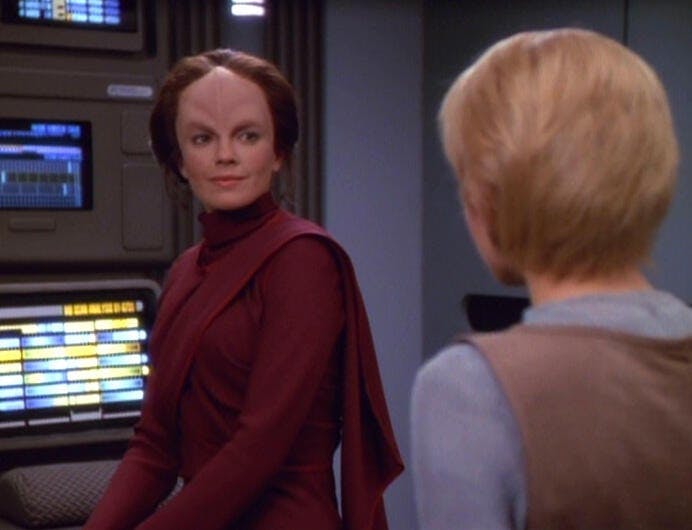
StarTrek.com
Now that she’s had access to this holographic version of herself, Danara wants to keep it. And why wouldn’t she? Add in the fact she’s found love and believes it to be in part because of her projected image, one can’t exactly fault her for wanting to keep this version of reality. She deliberately administers nytoxinol to try and kill her Phage ridden body, preferring her life as a hologram. The self-destruction, the desperation for a better version of yourself — these are all things I identify with; that I understand. If I was Danara, I would have done the same thing.
“I don’t ever want to be her again,” she cries out. The Doctor doesn’t understand. He loves Danara for who she is, not what she is. It’s something the Vidiian has trouble wrapping her head around. A feeling anyone who can’t understand or take compliments knows well.
There’s Nothing Sadder Than a Missed Opportunity
The Doctor and Danara have a bittersweet ending. They fall in love, but only have a little time with one another. He does, however, convince Danara that his feelings about her will not alter if she returns to her actual body. To prove this, the first thing The Doctor does when Danara is in her body once more is touch her diseased skin lovingly. And then they dance a program he downloaded just for her. It’s touching and romantic and just the right level of cheesy to warm the cockles of your heart.

StarTrek.com
It gives me some hope. Hope that one day I can ease up on the apps and filters and get rid of them all together. Hope that one day I won’t feel so self conscious, that my self esteem won’t get in the way of taking a chance at happiness with someone.
The Doctor fell in love with Danara for her personality, her kindness, and her intelligence. She gave him a name and a life, and he gave her confidence and an appreciation for herself and her work. In today's Instagram-fueled culture of filters, superficial pressure, and putting a fake version of your life on social media, the beauty of The Doctor's appreciation and love for Danara Pel serves to remind us of the cheesy, yet truthful reality that it's what on the inside that counts.
This article was originally published on February 12, 2020.

